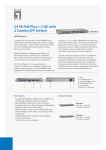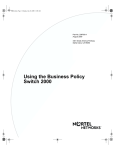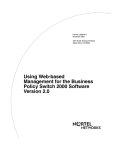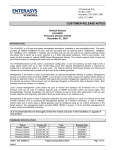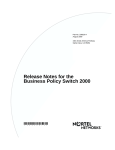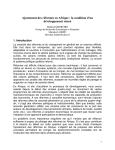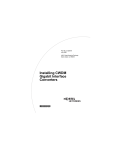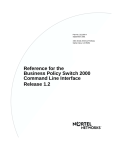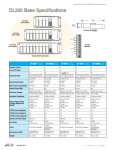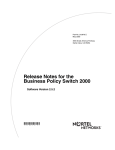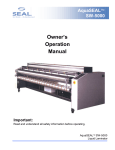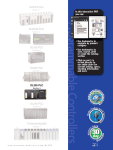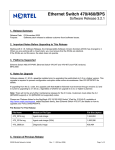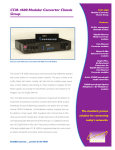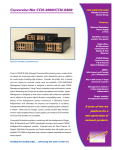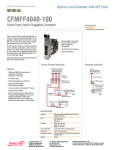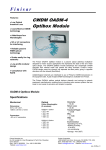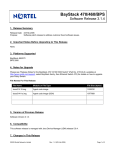Download Avaya Engineering Tips & Tricks, November 2003, vol 5 User's Manual
Transcript
Volume 5, November 2003 Did You Know… Meridian Integrated Personal Call Director (MIPCD) Music File: The current software release on the MIPCD is 1.5. When the “one number” is called and the MIPCD begins to search for the user based on the “follow me” profile, music is played. At present the music being played is a “fixed” program in that it must be used and no alternate file can be loaded to the MIPCD. Customized music files IN THIS ISSUE Interoperability • OM5000 ITU CWDM OMX and Finisar OADM • MLT Interoperability between PP8600 and BayStack Series Switches Technology • Fiber Channel (FC) Basics Network Management • Installing Preside Trail Manager from the Hard Disk Routers / Switches • PPP/HSSI CRC Size Difference between a Contivity 2600 and a Backbone Node BLN • Contivity EF Egress Shaping vs. Interface Shaping • Passport 8600 “Outloss Packets” Statistic Explained cannot be used until Release 2 which is planned to be released in 2Q/04. The music file that is about 1 minute in duration will be approximately 1MB in Wireless LAN • 802.1x for Wired Networks • Throughput on Wireless LANs size. 1 INTEROPERABILITY OM5000 ITU CWDM OMX and Finisar OADM The Nortel Networks OM5000 ITU CWDM OMX provides a superior alternative to the Finisar CWDM Optical Multiplexer (OMUX). The OM5000 CWDM OMX is available in a 4-port or an 8-port version, and provides the following advantage over the Finisar OMUX’s: 1. Significant reduction in price 2. Lower dB loss (in some cases); hence longer fiber distance For point-to-point CWDM designs, the OM5000 CWDM OMX’s can be used to mux/demux up to 8 wavelengths on a single fiber cable. For CWDM ring implementation where various wavelengths are dropped at different sites, the OM5000 CWDM OMX can be used with the Finisar Optical Add-Drop Multiplexer (OADM). This configuration was tested thoroughly in Nortel Networks Core Systems Engineering (CSE) Labs using the test configuration illustrated below The test configuration represents a typical small-scale CWDM network design. The core of the network consists of two peer Passport 8600’s running SMLT to the remote sites. Each Passport 8600 in the core connects to the fiber ring using an 8-port OM5000 CWDM OMX. Site one is serviced by the 1470nm wavelength, site two is serviced by the 1490nm wavelength, and site three is serviced by the 1530nm wavelength. Each of the 3 sites uses a BPS2000 equipped with a dual mini-GBIC MDA. At each of the sites, the link on the left side of the OADM (which represents the wavelength that is dropped from the west side of the ring) provides the connection to Core Node A, and the link on the right side of the OADM (which represents the wavelength that is dropped from the east side of the ring) provides connection to Core Node B. For optimum resiliency, the sites are connected to the core using Split-MLT. In order to test the impact of failing fiber links in the CWDM core, real-applications; including MPEG-2 video streaming, Web client/host browsing, and Voice over IP applications were used. Failure testing included failing and recovering all the links along the CWDM ring (Link1, Link2, Link3, and Link4) as illustrated on the network diagram. Sub-second fail-over was always achieved, both upon a link failure or a link recovery, and the failure was fairly transparent to the user applications. For link budget engineering, the following is an example and a comparison using the OM5000 CWDM OMX verses the Finisar CWDM OMUX: Constants • Loss Budget for APD Optics = 24db • Finisar OADM Add Loss = 1.2db • Finisar OADM Passthrough Loss = 1.5db • OM5000 CWDM OMX 4ports Drop Loss = 2.4db (worst case) • OM5000 CWDM OMX 8ports Drop Loss = 3.9db (worst case) • OM5000 CWDM OMX 4ports Add Loss = 2.1db (worst case) • OM5000 CWDM OMX 8ports Add Loss = 3.7db (worst case) • Finisar OMUX Drop Loss = 4db (worst case) • Finisar OMUX Add Loss = 3dB(worst case) • System Margin = 3db • Sigma = 2.4db • Attenuation per Kilometer = will depend of the type of fibers. Fiber characterization should be performed on fibers span to get the dB per Km or miles. In some cases, the fiber loss included the connectors. If the connectors are not included, an average of .5dB loss per connector should be counted. 2 Calculations per wavelength The link budget has to be calculated for every wavelength. The following should be included: The two most common protocol mappings for Fiber Channel are FCP, which is SCSI over FC and FC-SB2, single byte command code set for FICON. • FICON comes as an ESCON evolution and is based on the Fiber Channel Standards. FICON support started bridging from FICON channels to existing ESCON Directors and ESCON Control Units, delivering value using channel consolidation, cable reduction, increased distance and increased device address-ability. Since FICON is just another upper layer protocol using standard Fiber Channel transport, FICON Directors are highly available Fiber Channel switches with capabilities that allow in-band management. • • • • Passthrough Nodes = Number of OADM between Add OADM and OMUX Passive Loss = OADM Add + OMUX Drop + (Passthrough Nodes*OADM PT) Implied Fiber Loss (IFL) = Loss Budget for fiber span Passive Loss – Margin (refer to as customer margin) – Sigma (standard deviation average loss for the components) Max Transmission Distance = IFL (see above)/Attenuation per Kilometer = MLT Interoperability between PP8600 and BayStack Series Switches When configuring Multi Link Trunking on the PP8600 platform, one must remember to use the same media type (i.e. Single Mode, Multi Mode, 100BaseT, 100FX, etc.) for all links in that MLT relationship. This is important to remember when engineering a network consisting of both PP8600’s and BayStack Series switches. Baystack switches will allow different media types in the relationship. Java Device manager will provide an error messages if differing media types are specified on the PP8600 during configuration. The Fibre Channel flow control mechanism is credit based to ensure there is never any congestion in the end to end path, unlike IP mechanisms. Within a fibre channel switch these credits are commonly referred to as “buffer credits.” Similar to the OSI model of seven (7) layers, the Fiber Channel architecture is structured in 4 layers. FC-4 FC-3 FC-2 TECHNOLOGY Fiber Channel (FC) Basics Fiber channel combines the best of channel and network technologies. Essentially a data pipe, a channel is a directly attached and well-structured mechanism designed to transmit data between a host and a fixed number of peripheral devices. The two most common channel protocol mappings are SCSI and ESCON. A network is designed to be dynamic and redundant; it must automatically adjust to a changing environment and support a varying number of nodes. It provides flexibility in connectivity leading to greater scalability and provides greater distances than channels. This gives FC the high speed of channels and the dynamic connectivity of networks. Upper layer protocol (ULP) mapping Services for multiple ports on one node Frame format, sequence and exchange management, flow control, CoS, Login/logout, topologies and segmentation and re-assembly 8B/10B character encoding FC-1 Signaling, media specifications, RX/TX specifications FC-0 FC-0 and FC-1 can be compared to the physical layer of the OSI model, while FC-2 is similar to a portion of the data link layer. FC-3 is for common services for devices with multiple ports (i.e. login server, Name server and alias server and so on) and finally FC-4 defines how upper layer protocols (SCSI) are mapped to fibre channel similar to the OSI transport layer. A good source for storage information can be found at the IBM storage site at http://www.storage.ibm.com/ 3 NETWORK MANAGEMENT Installing Preside Trail Manager from the Hard Disk Trail Manager 4.2.4 Service Pack 1 is distributed on CD-ROM and is typically installed in this format at customer locations. The user documentation details the installation procedure (in the Trail Management 4.2 SP1 Administration Guide NTP 450-3101-094) from CD-ROM. When running the install script the following line asks for the device type: Enter the type of device [cdrom (default), tape, 'abort' to quit] This appears to imply that Trail must either be installed from CD-ROM or Tape. While these are the common sources for the software, in a lab environment it may be useful to be able to install from a set of files located on the local or remote hard disk. Installing from a file can be easily accomplished by selecting ‘cdrom’ as the option when asked for the source. The next item that the install script will ask for is the mount point: Enter CD-ROM mount point, or Type 'abort' to quit [/cdrom] : In this field, instead of entering a CDROM mount point, enter the directory location where the Trail Manager files are located (eg. /tmp/tm57bw). The Trail Manager install script does not distinguish between this directory location and a cdrom mount point, so it will proceed to install Trail from this location providing all relevant files are placed in this directory (i.e. the directory must appear as a cdrom would). ROUTERS / SWITCHES Click on the HSSI interface Click ‘Edit Line’ Set the CRC size to ’16 bit’ Click OK Contivity EF Egress Shaping vs. Interface Shaping Contivity V4.8 supports both EF egress shaping and Interface shaping. Here is a list of comparisons between the two shaping features: • They both delay the outgoing packet flow through egress interface. Non-conforming traffic is delayed, not dropped. • They are both disabled by default, and have to be enabled before functioning, and both support configurable shaping rate. • Interface shaping applies to all traffics regardless of protocols or markings, while EF egress shaping applies to EF marked packets only. • Interface shaping is available on the Ethernet interface only, while EF egress shaping applies to Ethernet, T1, HSSI, V35, X21 WAN interfaces. • If both shaping features are enabled and configured on Ethernet interface, whichever has the smaller shaping rate will control EF egress shaping rate. To enable EF egress shaping, in the Main menu >QoS->QoS Interface, select “Enabled” for “Traffic Conditioning State” to the desired interface. Then configure the desired shaping rate on “Expedited Forwarding Shaping Rate” for Egress (Outbound). Below is a lab demo. Both shaping features are enabled on public interface, slot 4, Ethernet interface 1. Shaping and MF are disabled on private interface. PPP/HSSI CRC Size Difference between a Contivity 2600 and a Backbone Node BLN In recent testing it was discovered that the default CRC sizes on a HSSI/PPP link between a Contivity 2600 and Backbone Node are different. The Contivity HSSI interface defaults to a 16 bit CRC and the BN HSSI interface defaults to a 32 bit CRC. In order for the PPP link to come up, one must change the BN’s HSSI interface to a 16 bit CRC. From Site Manager: Contivity FTP Slot 4, Ethernet interface 1 FTP Disable Shaping download large size file First, setup Public Interface shaping rate = 6M, and EF shaping rate = 2M. And MF marking is enabled 4 with a rule to mark all IP as EF. Make sure the user profile has default setting “excess action: Mark”. prevents successful reassembly of an egress frame. This can occur for two principal reasons: ¾ ¾ An 802.3x PAUSE frame was received on an Ethernet link, and queued egress traffic depleted available buffer space while the pause function timer was counting down or before a 0pause_time PAUSE frame (which would resume transmission) could be processed. Egress traffic oversubscribes a port’s capacity, such as when traffic entering at multiple ports switches to a single output port, or in the case where traffic bursts between input ports of high speed to a port of lower speed. In these cases, the OctaPID buffers what traffic it can, and when buffers are full, additional frames must be tail-dropped, causing the counter to increment. There are a couple of mitigating considerations when observing an incrementing Outloss Packets counter. Download a large size file from the FTP server to the client. The max FTP speed is about 2Mbps. Why? Since EF egress shaping rate of 2M is smaller than the interface shaping rate of 6M, the EF egress shaping rate governs the FTP speed. Reconfigure the shaping rates as Interface shaping rate = 3M, and EF egress shaping rate = 6M. Download a large size file from the FTP server to the client. The FTP speed is about 3Mbps, since the Interface shaping rate of 3M is smaller than the EF egress shaping rate of 6M. Passport 8600 “Outloss Packets” Statistic Explained A statistic displayed from the Passport 8600 CLI, labeled “OUTLOSS PACKETS,” is not explained in the product documentation. To view the display, enter the command: # show port stats interface main The Outloss Packets statistic counts the number of frames that were dropped by an I/O port’s OctaPID while the frame was being reassembled for transmission. The OctaPID reports the statistic as part of the OctaPID egress queuing function, and increments when a lack of output buffer space In the case where traffic is lost due to flow control, since 802.3x flow control was designed in the mid1990s specifically to make it easier to design and manufacture input buffered switches, sometimes it makes more sense to turn off flow control on the neighboring switch if the neighboring switch has an output buffer or shared memory design. The neighboring switch may have more capacity to buffer traffic than the OctaPID that is discarding traffic due to receipt of the PAUSE frames. To observe line flow control frame reception, read the 802.3x interface flow control frame counters from the same “show port stats interface main” command. Experiment for best results with link layer flow control on a case by case basis. Where egress traffic oversubscribes port capacity, higher layer protocol flow control mechanisms sensitive to discards should properly throttle traffic, and the network system is behaving as designed. At the network maintenance level no defect should be inferred, though from a design perspective, the congestion pattern indicated by Outloss Packets might be studied if users complain of unsatisfactory service. The output buffer capacity of an OctaPID is best utilized in conjunction with DiffServ (QoS). Marked traffic streams distributed among more of the eight available hardware queues will better utilize the 5 OctaPID’s buffer space than a single queue used by unmarked (or uniformly marked) traffic. including the VLAN Id and the Ethernet port priority which are dynamically configured on the port. Outloss Packets counters presently have no MIB object and cannot be polled using SNMP. 802.1x uses Extensible Authentication Protocol (EAP) which provides a generic transport mechanism for support various authentication protocols. Nortel’s Ethernet Switching products play the role of the EAP Authenticator and support various EAP types including TLS, TTLS, MD5, and PEAP. The following Nortel Products support 802.1x/EAP: Finally, to clear a possible point of confusion, note that this OctaPID statistic is different from the MACreported interface statistic for excessive collisions on half-duplex Ethernet or Fast Ethernet links (displayed via “show port error collision”). Excessive collisions (16 successive attempts to transmit using CSMA/CD on a half duplex Ethernet or Fast Ethernet link all resulting in collisions) can only increment on a congested half duplex link, while Outloss Packets can occur any time congestion causes OctaPID transmit buffer depletion. Frames dropped due to Excessive Collisions do not affect the Outloss Packets counter; although of course Outloss Packets might occur if enough frames are queued up while others await transmission on a congested half-duplex link. For more information on the relationship between physical port and assigned OctaPID, see “Managing Platform Operations and Using Diagnostic Tools – Passport 8000 Series Software Release 3.5,” Appendix D, “Tap and OctaPID Assignment,” pp.251256. For more information on CLI statistical displays, see the section “Showing Port Statistics,” starting on p.195. For a better understanding of OctaPID QoS and buffering properties, see “Network Design Guidelines Passport 8000 Series Software Release 3.5 Implementation Notes,” section titled “QoS and network congestion,” pp.337-342. at Customer Support Documentation WIRELESS LAN 802.1x for Wired Networks The IEEE 802.1x standard “Port Based Network Access Control” has received a lot of attention for improving the security of wireless networks. Many Enterprises are also exploring the use of 802.1x for their wired networks as well. This would force endusers to authenticate against a database (ex. RADIUS) before gaining access to the network. If the user is successfully authenticated the database can optionally return attributes specific to the user 1. 2. 3. 4. 5. 6. BayStack 450 – starting with version 4.0 BPS2000 – starting with version 1.1 BayStack 470 – starting with version 2.2 BayStack 425 – will support with BoSS 3.0 BoSS 3.0 supports EAP Passport 8300 – will support EAP in first release 7. Passport 8600 – will support EAP in next release Throughput on Wireless LANs In general, when referring to the performance of a Wireless LAN (WLAN) typically the data rates are quoted, 11 Mbps for 802.11b and 54 Mbps for 802.11a. However, end-user application throughput is always lower because of protocol overhead and additional delays associated with accessing the shared wireless medium. It is important to make this distinction as the throughput numbers should be used when designing WLAN networks. For each packet that is transmitted the following factors affect the throughput: 1. Protocol Overhead - Physical Layer Convergence Procedure (PLCP) and Medium Access Control (MAC) layer preamble and headers are added to each packet. The PLCP preamble and header is always transmitted at the lowest data rate. 2. Inter-Frame Spacing – each WLAN technology (i.e. 802.11a, b, and g) specifies different values for spacing between transmitted frames. This is also dependent on the basic data rate. 3. ACK – transmitting data on WLAN networks is reliable; thus, for each unicast packet transmitted an ACKnowledgement must be received before the next packet is sent. 4. Back-off time – WLAN clients implement a Carrier Sense Multiple Access Collision Avoidance (CSMA/CA) mechanism in order to avoid 6 collisions. Once a Client determines that the channel is clear it will wait a random period of time before transmitting in order to decrease the probability that two Clients will transmit at the same time which would result in a collision. the AP experiencing minimal interference AP thereby communicating using the highest basic data rate. Again, not realistic but understanding the limits of WLAN performance is useful when designing WLAN networks. As a result of these factors the maximum theoretical throughput for 1500 byte packets in an 802.11a environment is approximately 31 Mbps and in an 802.11b environment is approximately 6-7 Mbps. The performance degrades as the packet size gets smaller so realistically actual throughput is even less. This is a key point to keep in mind when using Voice or Video applications on WLANs. These calculations also assume that there are no collisions and that each mobile client and is close to _________________________________________ To receive Engineering Tips and Tricks direct in your email box… If you are authorized Nortel Networks Channel Partner, you can receive it through our bi-weekly Partner NewsFlash (PNF). Sign up for access to our password protected website, Partner Information Center, and you will be automatically subscribed to PNF (note: you may unsubscribe at any time). If you are an Enterprise customer, you can receive it through our Nortel Networks Update. Subscribe for this monthly e-newsletter to provide you with the latest updates on Nortel Networks, Products and Solutions, Training and Certification, Industry News, Events, Promotions, and much more. This publication will evolve based on your content and information requirements, therefore please feel free to provide feedback on the design and organization of this publication to: [email protected]. 7








